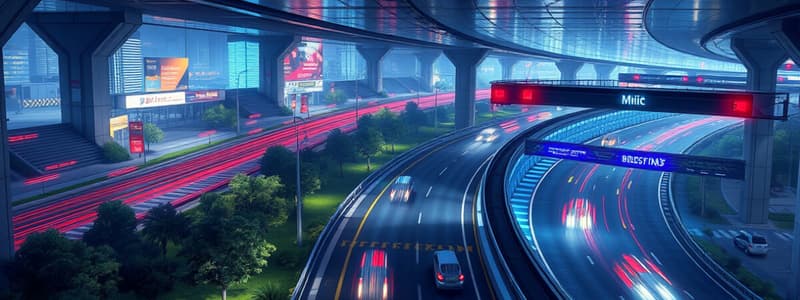Podcast
Questions and Answers
Which aspect is NOT a primary focus of transportation engineering?
Which aspect is NOT a primary focus of transportation engineering?
What is a key factor in air transportation design?
What is a key factor in air transportation design?
What does Level of Service (LOS) in transportation engineering assess?
What does Level of Service (LOS) in transportation engineering assess?
Which of the following considerations is essential for roadway design?
Which of the following considerations is essential for roadway design?
Signup and view all the answers
Which trend emphasizes technology use in traffic management?
Which trend emphasizes technology use in traffic management?
Signup and view all the answers
What is the main goal of sustainable transportation?
What is the main goal of sustainable transportation?
Signup and view all the answers
In traffic engineering, which technique is used to manage traffic flow?
In traffic engineering, which technique is used to manage traffic flow?
Signup and view all the answers
Which design element is critical for public transportation systems?
Which design element is critical for public transportation systems?
Signup and view all the answers
Which tool is primarily used for analyzing and managing transportation data?
Which tool is primarily used for analyzing and managing transportation data?
Signup and view all the answers
What must engineers prioritize when designing transportation infrastructure?
What must engineers prioritize when designing transportation infrastructure?
Signup and view all the answers
Which agency is NOT typically involved in the regulatory oversight of transportation projects?
Which agency is NOT typically involved in the regulatory oversight of transportation projects?
Signup and view all the answers
What is a key use of Drones and UAVs in transportation engineering?
What is a key use of Drones and UAVs in transportation engineering?
Signup and view all the answers
Which of the following is NOT a function of Traffic Simulation Software?
Which of the following is NOT a function of Traffic Simulation Software?
Signup and view all the answers
Study Notes
Overview of Transportation Engineering
- Branch of civil engineering focused on the design, construction, and maintenance of transportation systems.
- Aims to ensure safe, efficient, and sustainable movement of people and goods.
Key Components of Transportation Engineering
-
Roadway Design
- Elements: horizontal and vertical alignment, lane width, shoulder design.
- Considerations: drainage, sight distance, and safety features.
-
Traffic Engineering
- Focus on traffic flow and control.
- Techniques: signal timing, signage, and road markings.
- Tools: traffic studies and simulations.
-
Public Transportation Systems
- Design of systems like buses, subways, and light rail.
- Emphasis on accessibility, scheduling, and integration with other modes.
-
Air Transportation
- Involves the design and operation of airports.
- Key factors: runway design, air traffic control systems, and passenger facilities.
-
Water Transportation
- Design of ports, harbors, and navigation systems.
- Focus on mooring structures, docks, and environmental impacts.
Design Considerations
-
Safety
- Incorporation of safety measures to reduce accidents.
- Use of standards and guidelines (e.g., AASHTO, FHWA).
-
Capacity and Level of Service
- Assessment of roadway capacity and traffic flow efficiency.
- Level of Service (LOS) metrics to evaluate performance.
-
Sustainability
- Promoting environmentally friendly practices.
- Use of alternative materials and methods to reduce carbon footprint.
Emerging Trends
-
Smart Transportation
- Use of technology (e.g., IoT, AI) for traffic management and data collection.
-
Sustainable Transportation
- Focus on reducing greenhouse gas emissions and promoting public transit.
-
Active Transportation
- Encouragement of walking and cycling through improved infrastructure.
Tools and Technologies
-
Traffic Simulation Software
- Used for modeling traffic patterns and evaluating design alternatives.
-
Geographic Information Systems (GIS)
- Tool for mapping, analyzing, and managing transportation data.
-
Drones and UAVs
- Increasingly used for surveying and monitoring transportation infrastructure.
Regulatory Framework
- Knowledge of local, state, and federal regulations governing transportation projects.
- Familiarity with agencies such as the Federal Highway Administration (FHWA) and the American Association of State Highway and Transportation Officials (AASHTO).
Conclusion
- Transportation engineering is integral to modern infrastructure development.
- Engineers must balance safety, efficiency, and environmental impact in their designs.
Overview of Transportation Engineering
- A branch of civil engineering dedicated to the design, construction, and maintenance of transportation systems.
- Objectives include ensuring the safe, efficient, and sustainable movement of people and goods.
Key Components of Transportation Engineering
-
Roadway Design
- Incorporates horizontal and vertical alignment, lane width, and shoulder design.
- Must consider drainage, sight distance, and incorporate safety features to minimize accidents.
-
Traffic Engineering
- Concentrates on managing traffic flow and control mechanisms.
- Techniques include signal timing, proper signage, and road markings, while tools comprise traffic studies and simulations.
-
Public Transportation Systems
- Encompasses the design of buses, subways, and light rail networks.
- Aims for high accessibility, efficient scheduling, and seamless integration with other transport modes.
-
Air Transportation
- Focuses on airport design and operational efficiency.
- Key considerations include runway design, air traffic control systems, and passenger amenities.
-
Water Transportation
- Involves the design of ports, harbors, and navigational systems.
- Particular attention is paid to mooring structures, dock design, and environmental implications.
Design Considerations
-
Safety
- Emphasizes the importance of safety measures to diminish accident rates.
- Compliance with established standards and guidelines such as AASHTO and FHWA ensures highway safety.
-
Capacity and Level of Service
- Involves assessing roadway capacity and the efficiency of traffic flow.
- Level of Service (LOS) metrics are employed to evaluate transportation performance.
-
Sustainability
- Advocates for environmentally friendly design and construction practices.
- Involves using alternative materials and methods to significantly reduce carbon footprints.
Emerging Trends
-
Smart Transportation
- Leverages technology like IoT and AI to enhance traffic management and data collection capabilities.
-
Sustainable Transportation
- Prioritizes strategies to lower greenhouse gas emissions and boost public transport usage.
-
Active Transportation
- Promotes walking and cycling through the development of improved supportive infrastructure.
Tools and Technologies
-
Traffic Simulation Software
- Essential for modeling traffic patterns, assisting in the evaluation of various design alternatives.
-
Geographic Information Systems (GIS)
- Provides capabilities for mapping, analyzing, and managing comprehensive transportation data.
-
Drones and UAVs
- Gaining traction for surveying and monitoring the state of transportation infrastructure.
Regulatory Framework
- Requires knowledge of local, state, and federal transportation project regulations.
- Familiarizes engineers with key regulatory bodies such as the Federal Highway Administration (FHWA) and the American Association of State Highway and Transportation Officials (AASHTO).
Conclusion
- Transportation engineering is crucial for the development of modern infrastructure.
- Engineers must navigate the balance between safety, efficiency, and environmental stewardship in their designs.
Studying That Suits You
Use AI to generate personalized quizzes and flashcards to suit your learning preferences.
Description
This quiz covers the fundamentals of transportation engineering, focusing on the design, construction, and maintenance of various transportation systems. Key components such as roadway design, traffic engineering, public transportation systems, and air transportation are included to ensure a comprehensive understanding of this civil engineering branch.




